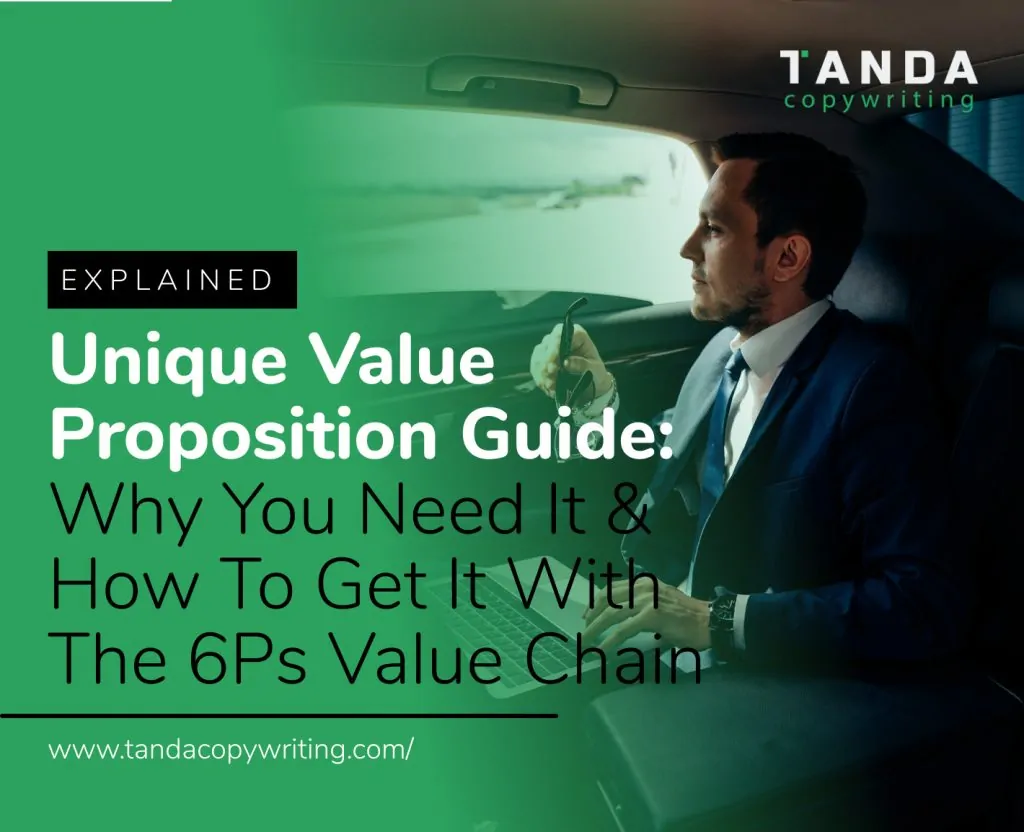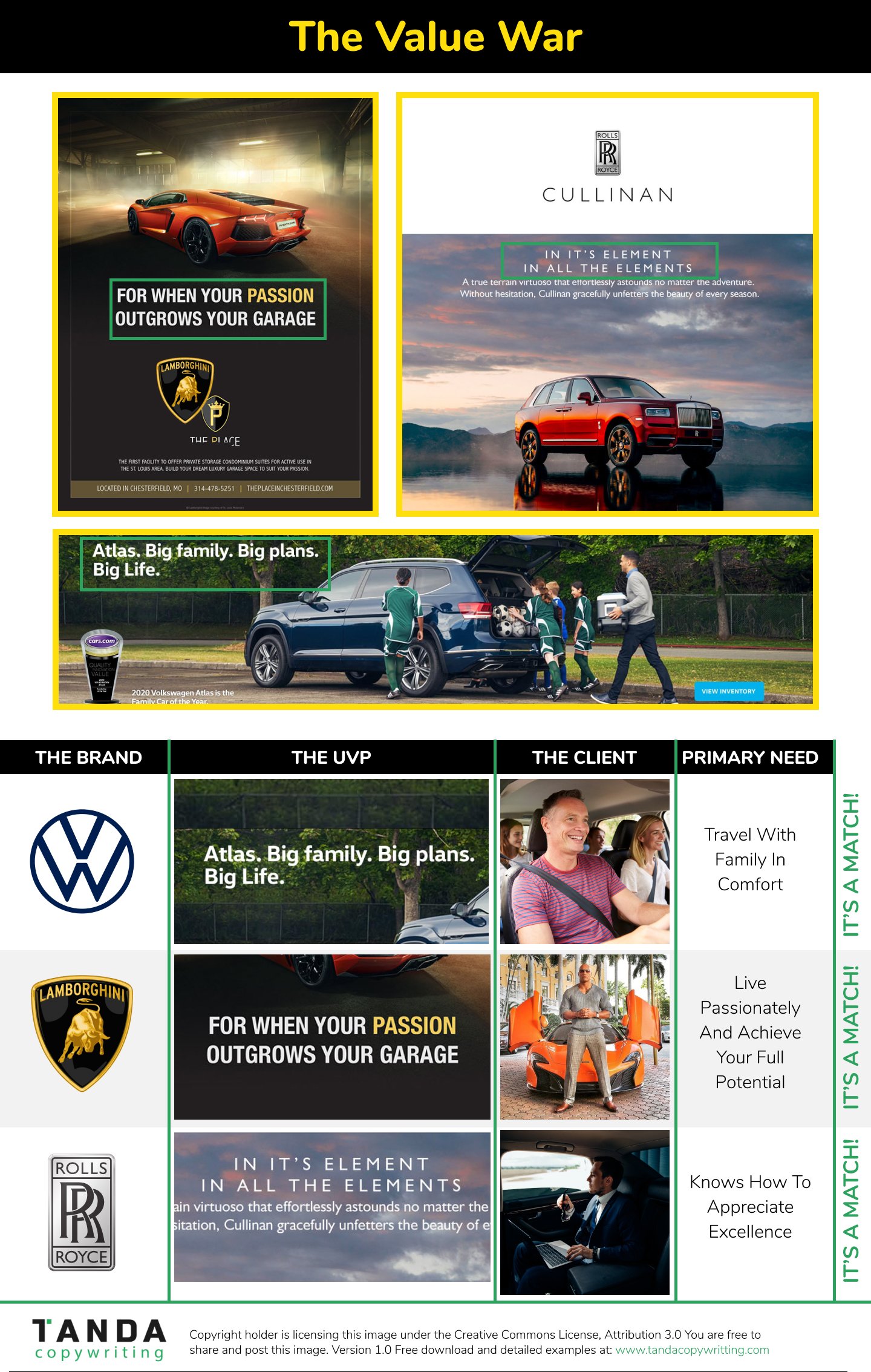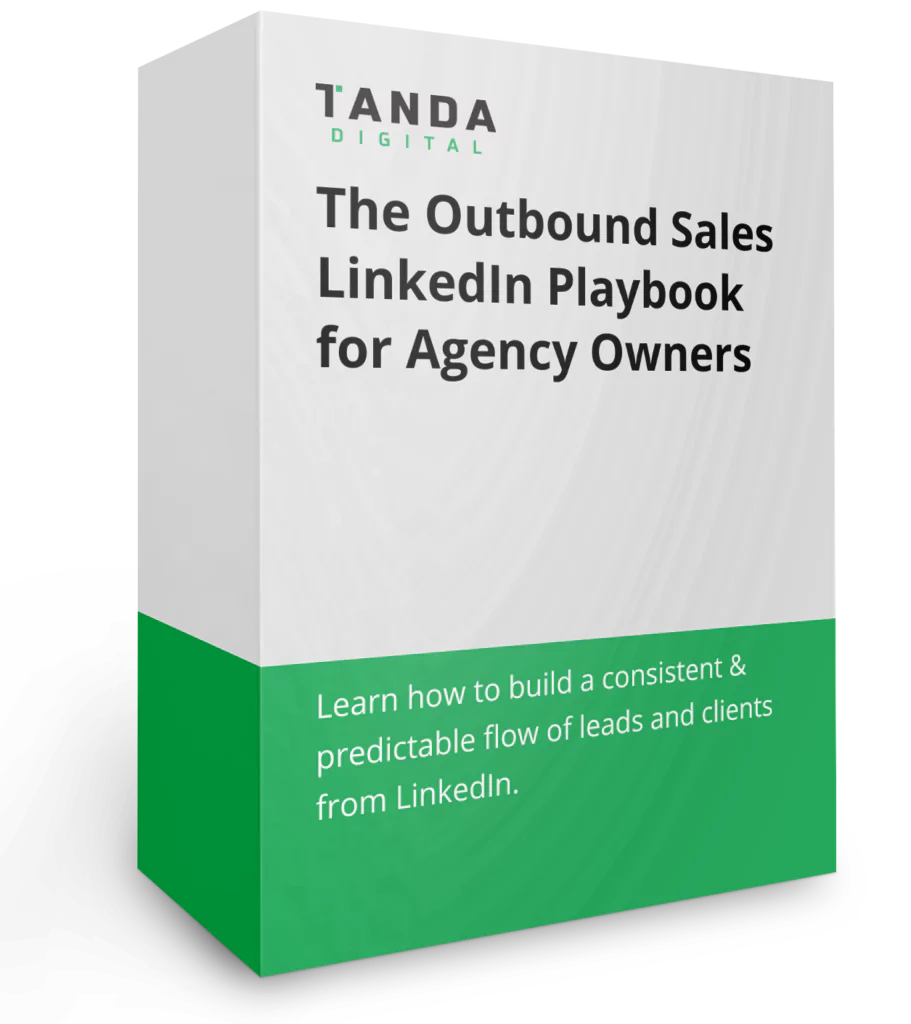Finding your Unique Value Proposition (UVP) is the single most important component of your marketing strategy. This may sound like an exaggeration, but it’s not. As much as 90% of your success can be determined by this.
So, if you’ve got the wrong UVP, then ALL your effort after that is wasted. The website you build, the ads you’ll run, your sales funnel – everything will be wasted time. You’re better off not doing any of it, because the results will not be there.
So it’s important to get this right. That’s why when working with my clients, I always use our proven proprietary framework which I call the 6Ps Value Chain to craft a solid UVP. This is the best marketing weapon you have, and it takes just 6 easy steps to create it.
What Is a Unique Value Proposition?
Put simply, it is the ONE differentiator that makes your business stand out from all the others. It is the ONE thing that you do better, that no one does like you.
The sad truth is that most businesses fail because they don’t have ANY UVP at all. Their marketing and thinking is tactical, NOT strategic.
So they jump from tactic to tactic (today it’s podcasts, tomorrow Google ads, and on it goes), without getting solid on their core message. They dilute their resources, and soon end up with none.
A winning business always creates a strong 4M Profit System. This means that the owner of the business (the ME factor), the MARKET, the MEDIA and the MESSAGE are aligned and working together to stand out and deliver outstanding value.
That’s how MASSIVE, MILLION-DOLLAR success is born, and that’s when the cash starts rolling in.
Let’s look at some examples of outstanding UVPs, that created millions or billions for the companies that had them.
1. Dominos Pizza – “You get fresh, hot pizza delivered to your door in 30 minutes or less or it’s free.”
This UVP took Dominos from a corner pizza place into a national chain. And it all happened because they offered a STRONG BENEFIT, backed up by a STRONG GUARANTEE that no one else put out there.
That’s why customers chose them, kept choosing them, and told their friends about Dominos. If you were a drunk college kid, you wanted to tell others about Dominos. You know why?
Because it showed your friends that you knew the best place to get pizza quickly at 3AM in the night. It made you popular.
2. Avis – “We’re number two. We try harder.”
If you’re number 2 in a market, it’s not the end. But any advertising that says “we’re the best” falls on deaf ears. Because your customer will think if they’re the best, why aren’t they number one?
So the solution that Avis found was to develop a UVP that accepted their position, and turned it into a reason why customers should choose them. And that reason was that they have a reason to try harder – they’re number 2.
So with Avis, the customer can count on receiving better service. The message worked. It made millions for Avis.
3. FedEx – “When it absolutely, positively has to be there overnight.”
FedEx is the idea that was laughed at by everyone. They expected 167 orders the first day, and the number of actual orders was just 7 – with only 2 orders by people who weren’t involved with the company.
But what FedEx had going for them was a message that resonated and offered a unique benefit that no one did. Guaranteed overnight deliveries.
Soon, people heard that if you had to get it delivered fast, you had to go to FedEx. And FedEx grew into a BILLION dollar company as the word spread.
4. Dollar Shave Club – “Affordable blades to your door.”
How do you emerge as a huge player in a market dominated by giants like Gilette and Schick? You do so by offering something unique, that delivers value above and beyond what the other players offer.
Dollar Shave Club offered affordable blades, delivered to your door. Convenience. It served people who didn’t care about the technicalities of each blade, but just wanted something simple and reliable that got the job done.
The UVP built this company into a giant.
5. DeathWish Coffee – “Wake up with the world’s strongest coffee”
Coffee is a very crowded market right? But there is always place for someone with a strong UVP. Like DeathWish Coffee.
Their UVP was simple – this is the strongest coffee you’ll ever drink, and if this doesn’t wake you up in the morning, then nothing will. Suddenly, when customers who wanted a strong coffee compared DeathWish with alternatives, DeathWish was really their ONLY choice.
A strong UVP positions your business as the ONLY meaningful choice for your target audience.
Why Is Having a Unique Value Proposition Important?
The goal of all your marketing efforts is to communicate something to your prospects that will get them to open their wallets and buy from you.
WHAT you’ll communicate, in different ways, through different mediums, and through different messages is your UVP.
So your UVP is literarily the center of gravity of all your marketing efforts. Mess this up, and everything else you do won’t save you. Get it right, and you can make a lot of other mistakes in execution and still succeed.
The Value War
There is a Value War going on in every market. Subjectively, this manifests itself as a battle between all the products that the customer knows about, to discover the one that best fits their needs.
Think of the customer’s mind as a lock. The lock is unlocked when a message hits the right combination – the combination that fulfills the customer’s needs.
So inside their mind, the customer compares your product, with alternatives, matching the benefits each product offers, with their needs:
When their NEEDS MATCH your UVP, and NOT the UVP of the other product, then they buy from you.
And that’s why your UVP must be UNIQUE – it must be the REASON WHY your customer will choose YOUR PRODUCT as the WINNER of the Value War.
So here is the proprietary framework we developed to make sure that the UVP is a unique differentiator that can help you unlock the combination for your target audience.
The 6Ps Value Chain: The Best Way To Create Your UVP
The previously listed companies did not know about the 6Ps Value Chain. But they unconsciously went through each and every step. These steps are now explicitly defined so that anyone can use them.
Each step you complete unlocks the next one, and by the end of the chain, you have a complete UVP that works.
The 6 Value Chain Links are: PERSON -> PROSPECT -> PAIN-POINTS -> PLAYERS -> PLEDGE -> PROOF
1. PERSON
A lot of companies end up with “me-too” value propositions that are not unique at all. And the reason why is because the business owners don’t build their value proposition around who THEY are. Their own PERSON.
If they did, then they would end up with something unique, at the very least, since they are unique.
So the start is always with your own person. Yourself.
You have to get clear about who you are, what kind of business you want to run, and what your values are.
They will shine through your business, and if there is no coherence between your values and your business, things aren’t going to work out. Because you’ll sabotage the business, unconsciously.
To complete the first chain link you must determine three things: your values, your goals, and your identity.
What do you want your business to look like? Who do you want to work with? What kind of lifestyle do you want to build? What are your own goals?
Everything else will be built around this. If you want to build a 100 million a year organization, you will make different decisions further down the road than if you want a lifestyle business and freedom.
Take the example of Avis. They started from who they were and wanted to be.
They were not the market leader in the car rental market. Hertz were.
So Avis built a USP around their own PERSON, in their own image.
They were number 2. They transformed that into a strength. Because they were number 2, they always tried harder, because they really desired to be number 1.
2. PROSPECT
The next chain link in the 6Ps Value Chain is the Prospect. Who are you going to serve? Who is your target market?
This is a critical chain link, because these people have the money that you want. There are several considerations here.
By Pareto’s Law, 20% of your customers will provide 80% of your revenue. And 4% of your customers will provide 64% of your revenue. You want to identify WHO the 4% are, so that you can focus just on them.
In this manner, you will magnify the results of your effort.
The other consideration here is that you want to make sure this is a group of people who will benefit massively from doing business with you. Basically the people who will perceive your service or product as truly valuable.
Let’s take the example of Dominos Pizza. For them, the ideal prospect was the student on college campuses ordering pizza at 3 AM after a drunken night.
What were the values of this ideal customer? They wanted a FAST delivery, of quality pizza, that was reliable. And they also wanted to be certain of it.
So with their slogan, Dominos hit the nail on the head. It pledged that their fresh, hot pizza would be there in 30 minutes tops, or it would be free.
Exactly what the target prospects needed.
So to complete this link, identify your target prospect (if you have multiple target prospects, you’ll want multiple UVPs, one for each group) and the psychographics that give you insight into their desires and needs.
3. PAIN-POINTS
Once you’re clear about your PROSPECT, you want to identify their hot buttons – their PAIN-POINTS. These are the issues that they care most about, above and beyond everything else.
Let’s take a quick example from FedEx. They identified that their prospects were getting harmed by the fact that package deliveries got delayed.
They had to get something quickly to its destination.
Once this pain-point was identified, they built a USP that would hit it, hard – “when it absolutely, positively has to be there overnight”
The massive number of customers frustrated with delays immediately responded to this message.
So you want to identify the PAIN-POINTS of your PROSPECTS, and then also identify what the DESIRED RESULTS would be that would solve the pain-points. That completes the value chain link.
4. PLAYERS
No UVP can have impact or be unique, if it doesn’t take into account the other PLAYERS on the market. Your competitors.
The goal at this stage is to identify a GAP in the market. Meaning a discrepancy between the pain-points you identified in the previous chain link, and what your competitors are offering.
Virtually ALL successful businesses do this. It’s what makes the USP unique and provides marginal value – value over and above what already exists in the marketplace.
This is the difference between having a point-of-entry benefit as your USP (basically a benefit you’re required to fulfil to even participate in the market), and a point-of-difference benefit (something customers only find with you).
Take a look at Dollar Shave Club. In a very crowded market, with Gilette, Schick and other huge competitors, they quickly crafted a name for themselves by tackling a pain-point that the others were ignoring.
What was the pain-point? Convenience. Getting a razor blade with them is convenient. It’s delivered monthly, you set the subscription, and then you can forget about it. And the razors are affordable, nothing fancy, just what gets the job done.
So to analyze your competitors, you must look at the benefits they’re offering, the level of service, the speed of delivery, the convenience for the buyer and so on. Make a list of them.
Then look at the list of pain-points you’ve identified. Which pain-points aren’t adequately addressed? You’ll want to focus on those for the next step.
5. PLEDGE
And now, once you have clarified all the preceding sections, you want to craft a killer pledge to your customers. What UNIQUE BENEFIT will you offer them that they cannot get anywhere else?
This is what business is all about. Differentiating, and offering something different and better. If you can’t do that, then your business will probably fail or barely get by.
Look at the previously identified gaps in the market and pick the most important one. Then craft a promise that fulfils it.
DeathWish Coffee identified a gap in the strength of coffee. Yes, there were many other coffees delivering great flavors, taste and so forth.
But there was a gap in servicing customers who wanted to feel STRONG because of drinking coffee. Who looked at it as a cup of morning energy.
Their pledge was simple: “Wake up with the world’s strongest coffee”. Meaning you don’t have to wake up and be a zombie the entire morning… one cup of DeathWish will wake you up for good!
It was a unique pledge, adding a benefit that couldn’t be found elsewhere.
So look at the gaps you previously identified, and find pledges that you can make to your customers about your solution to the gap.
6. PROOF
You’ve made your PLEDGE, now it’s time to prove it. Time to back up your claim and make sure that your prospects believe it.
There are several ways to PROVE a claim for your USP. Let’s look at a few examples:
“You get fresh, hot pizza delivered to your door in 30 minutes, or it’s free”.
The proof here is in the guarantee. We trust the pledge so much, that we guarantee it.
“We’re number 2. We try harder”.
The pledge here is a reason why the claim is true. Basically we’ll devote more time to taking care of you, and the proof is that it’s in our interest to do so – we’re number 2, and we need to get to number 1.
In some cases, you don’t need any aspect of proof, because the promise is believable, since nobody offers it. But in most cases, you do need proof.
You need to back up the pledge you make, and show that it is real. Either through a guarantee, showing how it’s in your interest, or providing numbers or evidence that show that it’s true.
Basically your UVP is a lot more powerful if you combine the PLEDGE with a reason why the pledge is true.
Writing Your USP: Bringing The 6Ps Value Chain Together
Once you have the 6Ps, you need to bring them all together and craft your UVP in a single statement. This statement will be contained in all your marketing materials. There are several qualities that your UVP must have, and now is the time to make sure it has them.
So review your UVP statement, and make sure it ticks all the boxes below:
High Relevance
Make sure your UVP is HIGHLY RELEVANT to a burning pain-point of your target market. It must hit a painful point and show that you will solve it.
Crystal Clear Clarity
Your UVP must be clear. No fancy language, or hard to understand marketing concepts, that win awards, but don’t make any sales. When your prospect reads it, it must take him no thinking to understand the meaning. It must be crystal clear.
Memorable
The last thing you want is to have a USP that is hard to remember. Then it doesn’t stick, and your customers brush it aside. It must be memorable, easy to remember, say and write. So make sure you have a single statement, not a paragraph, that is simple and direct.
Reduces Anxiety
The UVP must reduce the anxiety your prospects have about the problem by offering a crystal clear solution to a burning pain-point. Keep your UVP as a positive, never go for a negative UVP.
Unique Differentiator
And finally, make sure that your UVP is a UNIQUE differentiator – something that gives your customers a reason to choose YOU over any other competitor. It means you must be the only one offering this specific benefit. If you go through the 6Ps Value Chain, you will achieve the unique factor.
Now It’s Time To Craft Your OWN UVP
Use the 6Ps Value Chain to craft a Unique Value Proposition for your own business. It will help you stand out, and get customers to flock to your door and give you their money.
It will help you improve your offers, and serve your market better than you currently do. And you may very well be the next Dominos, FedEx, or Avis!

Looking to Add Predictable Growth to your Business?
Hey, thanks for reading this article, I hope you got great value out of it. I'm the founder of TANDA Digital, Tudor Dumitrescu (click to follow me on LinkedIn) and I've made it my mission in life to empower 25,000 business owners to grow with confidence through systematic improvements in their business development processes.
If that sounds like something you want, there are 3 ways for me to help:
1. Download Our Outbound Sales LinkedIn Playbook™
To sample one of our business development strategies, you can get our LinkedIn Playbook™. I've used these tactics to bring in as many as 24 new clients in a single month for ourselves, and the 800+ companies who have tried it were impressed by the results. Get it here.
2. Attend One of Our Free Workshops
Every month I run one of two workshops. One for beginners, which I define as companies making less than $10K/mo and one for more advanced businesses who are already making $10K/mo and looking to take it to $100K/mo.
The Ascendancy™ Workshop is for agencies making less than $10K/mo who want to lay up a 7-figure foundation for their business. You will get worksheets and you will work together with me to apply the NPOT Methodology™ to choosing your niche, crafting your offer, defining your positioning, and working on your pricing & guarantee strategy.
The N³ Growth Model™ Workshop is for companies making more than $10K/mo who want to install a marketing system that will take them to $100K/mo. You will get worksheets and you will work together with me to apply the growth model into your business by refinining your Network Expansion, Nurturing and Negotiation processes to close big deals even during recessions.
3. Let us build a custom GDPR-Compliant Business Development System for you
If you want to go really fast and get big results ASAP, then the fastest path is to work with us to build a custom solution suited to your needs. You can contact us below for that:





